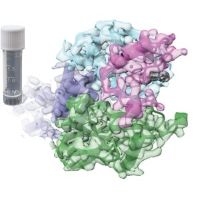Specification
| Description | Recombinant protein from the full-length sequence of Homo sapiens homeodomain interacting protein kinase 2 (HIPK2), transcript variant 1 (NM_022740). |
| Organism | Homo sapiens (Human) |
| Expression Host | Human Cells |
| Tag Info | His or DYKDDDDK. Please contact us if you need further information or require specific designed tag. |
| Purity | Greater than 90% by SDS-PAGE gel |
| Uniprot ID | Q9H2X6 |
| Entry Name | HIPK2_HUMAN |
| Gene Names | HIPK2 |
| Alternative Gene Names | |
| Alternative Protein Names | Homeodomain-interacting protein kinase 2 (hHIPk2) (EC 2.7.11.1) |
| Application | Antigens, Western, ELISA and other in vitro binding or in vivo functional assays, and protein-protein interaction studies; For research & development use only! |
| Buffer | Purified protein formulated in a sterile solution of PBS buffer, pH7.2, without any preservatives |
| Endotoxin | Endotoxin level is < 0.1 ng/µg of protein (<1EU /µg) |
| Length | 1198 |
| Molecular Weight(Da) | 130966 |
| Protein Sequence | (The sequence of expressed protein may have some variation from the sequence shown below. Please contact us for the exact sequence.) MAPVYEGMASHVQVFSPHTLQSSAFCSVKKLKIEPSSNWDMTGYGSHSKVYSQSKNIPLSQPATTTVSTSLPVPNPSLPYEQTIVFPGSTGHIVVTSASSTSVTGQVLGGPHNLMRRSTVSLLDTYQKCGLKRKSEEIENTSSVQIIEEHPPMIQNNASGATVATATTSTATSKNSGSNSEGDYQLVQHEVLCSMTNTYEVLEFLGRGTFGQVVKCWKRGTNEIVAIKILKNHPSYARQGQIEVSILARLSTESADDYNFVRAYECFQHKNHTCLVFEMLEQNLYDFLKQNKFSPLPLKYIRPVLQQVATALMKLKSLGLIHADLKPENIMLVDPSRQPYRVKVIDFGSASHVSKAVCSTYLQSRYYRAPEIILGLPFCEAIDMWSLGCVIAELFLGWPLYPGASEYDQIRYISQTQGLPAEYLLSAGTKTTRFFNRDTDSPYPLWRLKTPDDHEAETGIKSKEARKYIFNCLDDMAQVNMTTDLEGSDMLVEKADRREFIDLLKKMLTIDADKRITPIETLNHPFVTMTHLLDFPHSTHVKSCFQNMEICKRRVNMYDTVNQSKTPFITHVAPSTSTNLTMTFNNQLTTVHNQAPSSTSATISLANPEVSILNYPSTLYQPSAASMAAVAQRSMPLQTGTAQICARPDPFQQALIVCPPGFQGLQASPSKHAGYSVRMENAVPIVTQAPGAQPLQIQPGLLAQQAWPSGTQQILLPPAWQQLTGVATHTSVQHATVIPETMAGTQQLADWRNTHAHGSHYNPIMQQPALLTGHVTLPAAQPLNVGVAHVMRQQPTSTTSSRKSKQHQSSVRNVSTCEVSSSQAISSPQRSKRVKENTPPRCAMVHSSPACSTSVTCGWGDVASSTTRERQRQTIVIPDTPSPTVSVITISSDTDEEEEQKHAPTSTVSKQRKNVISCVTVHDSPYSDSSSNTSPYSVQQRAGHNNANAFDTKGSLENHCTGNPRTIIVPPLKTQASEVLVECDSLVPVNTSHHSSSYKSKSSSNVTSTSGHSSGSSSGAITYRQQRPGPHFQQQQPLNLSQAQQHITTDRTGSHRRQQAYITPTMAQAPYSFPHNSPSHGTVHPHLAAAAAAAHLPTQPHLYTYTAPAALGSTGTVAHLVASQGSARHTVQHTAYPASIVHQVPVSMGPRVLPSPTIHPSQYPAQFAHQTYISASPASTVYTGYPLSPAKVNQYPYI |
Background
| Function | FUNCTION: Serine/threonine-protein kinase involved in transcription regulation, p53/TP53-mediated cellular apoptosis and regulation of the cell cycle. Acts as a corepressor of several transcription factors, including SMAD1 and POU4F1/Brn3a and probably NK homeodomain transcription factors. Phosphorylates PDX1, ATF1, PML, p53/TP53, CREB1, CTBP1, CBX4, RUNX1, EP300, CTNNB1, HMGA1 and ZBTB4. Inhibits cell growth and promotes apoptosis through the activation of p53/TP53 both at the transcription level and at the protein level (by phosphorylation and indirect acetylation). The phosphorylation of p53/TP53 may be mediated by a p53/TP53-HIPK2-AXIN1 complex. Involved in the response to hypoxia by acting as a transcriptional co-suppressor of HIF1A. Mediates transcriptional activation of TP73. In response to TGFB, cooperates with DAXX to activate JNK. Negative regulator through phosphorylation and subsequent proteasomal degradation of CTNNB1 and the antiapoptotic factor CTBP1. In the Wnt/beta-catenin signaling pathway acts as an intermediate kinase between MAP3K7/TAK1 and NLK to promote the proteasomal degradation of MYB. Phosphorylates CBX4 upon DNA damage and promotes its E3 SUMO-protein ligase activity. Activates CREB1 and ATF1 transcription factors by phosphorylation in response to genotoxic stress. In response to DNA damage, stabilizes PML by phosphorylation. PML, HIPK2 and FBXO3 may act synergically to activate p53/TP53-dependent transactivation. Promotes angiogenesis, and is involved in erythroid differentiation, especially during fetal liver erythropoiesis. Phosphorylation of RUNX1 and EP300 stimulates EP300 transcription regulation activity. Triggers ZBTB4 protein degradation in response to DNA damage. Modulates HMGA1 DNA-binding affinity. In response to high glucose, triggers phosphorylation-mediated subnuclear localization shifting of PDX1. Involved in the regulation of eye size, lens formation and retinal lamination during late embryogenesis. {ECO:0000269|PubMed:11740489, ECO:0000269|PubMed:11925430, ECO:0000269|PubMed:12851404, ECO:0000269|PubMed:12874272, ECO:0000269|PubMed:14678985, ECO:0000269|PubMed:17018294, ECO:0000269|PubMed:17960875, ECO:0000269|PubMed:18695000, ECO:0000269|PubMed:18809579, ECO:0000269|PubMed:19015637, ECO:0000269|PubMed:19046997, ECO:0000269|PubMed:19448668, ECO:0000269|PubMed:20307497, ECO:0000269|PubMed:20573984, ECO:0000269|PubMed:20637728, ECO:0000269|PubMed:20980392, ECO:0000269|PubMed:21192925, ECO:0000269|PubMed:22825850}. |
| Pathway | |
| Protein Families | Protein kinase superfamily, CMGC Ser/Thr protein kinase family, HIPK subfamily |
| Tissue Specificity | Highly expressed in heart, muscle and kidney. Weakly expressed in a ubiquitous way. Down-regulated in several thyroid and breast tumors. {ECO:0000269|PubMed:11267674, ECO:0000269|PubMed:11798164}. |
QC Data
| Note | Please contact us for QC Data |
| Product Image (Reference Only) |  |

